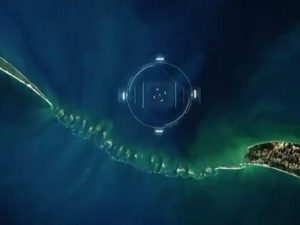ராமர் பாலம் – 7000 ஆண்டுகளுக்கு முன் நடந்த மனித உழைப்பு
 “Are the ancient Hindu myths of a land bridge connecting India and Sri Lanka true? Scientific analysis suggests they are,” claims the promo of a show called Ancient Land Bridge to be aired at 7.30 am Wednesday on the Discovery Communications-owned Science Channel in the US.
“Are the ancient Hindu myths of a land bridge connecting India and Sri Lanka true? Scientific analysis suggests they are,” claims the promo of a show called Ancient Land Bridge to be aired at 7.30 am Wednesday on the Discovery Communications-owned Science Channel in the US.
The show puts the spotlight once again on the Ram Setu by quoting American archaeologists who say the 50-km stretch — between Pamban Island near Rameshwaram in India and Mannar Island off Sri Lanka — is man-made. The Ram Setu is also called Adam’s bridge.
The promo has got more than 1.1 million views since it was shared by Science Channel on social media 16 hours ago.
Smriti Irani, the minister for information and broadcasting, also retweeted the video, with the caption ‘Jai Shri Ram’.
A shipping canal project proposed by the UPA-I government in 2005 that would have required dredging the area and damaging the formation was opposed by the BJP-led NDA, which is expected to file an affidavit against project in the Supreme Court later this month.
Satellite imagery show formations that scientists believe are limestone shoals. Creating a 83-km-long deep water channel under the Sethusamudram canal project would require extensive dredging and removal of the limestone shoals.
The project was criticised not just for hurting religious sentiments but also for threatening the marine biodiversity of the region.
The Science Channel trailer supports the theory that the bridge is man-made based on studies found atop the formation and quoting scientists from Indiana University Northwest, University of Colorado Boulder, and Southern Oregon University. At the time of the publishing of this article, the researchers had not responded to calls for comment.
“The sand bar may be natural but what is sitting on top of it is not,” says the narrator in the promo, pointing out that the rocks are 7,000 years old and the sand bar is only 4,000 years old.
Irani’s retweet of the trailer met with an outpouring of support and some ridicule. One Twitter user wondered why the Archaeological Survey of India wasn’t doing anything to resolve the matter.
“Jai Sri Ram….but what was ASI doing? This could have been done by us rather than science channel telling us. But no even after 2014 leftist thugs will still rule academics, ncert, history,” a twitter user by the name Sandeep Singh, said.
The Indian Council of Historical Research announced in March that it would conduct underwater studies to answer this very question. A report was expected in November, but archaeologist and former ASI director Alok Tripathi, who submitted the proposal, said work is yet to begin.
“We have not done the fieldwork. There are some formalities pending for the project to start,” Tripathi said. “Our conclusions will depend on what we find.”
The UPA-I government stirred up a storm when it filed an affidavit in Supreme Court saying there was no evidence that Ram Setu was a place of worship. The affidavit was later withdrawn.
On November 12, the court gave the government six weeks’ time to file an affidavit on their stance, reported ANI. Subramanian Swamy, who filed the petition in the court opposing the project, told reporters that the Narendra Modi government had decided to file a new affidavit suggesting alternative routes for the Sethusamudram project.
Ref : Hindustan Times






Leave a Reply